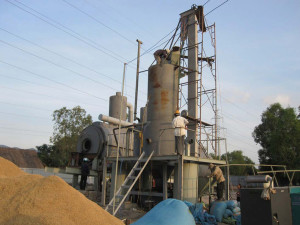
Access to modern energy services is fundamental to improving quality of life, deployment of health, educational infrastructure and socioeconomic development. However, today 25% of the world’s population lives without electricity. There is an urban-rural split in the electricity access challenge, with the International Energy Agency (IEA) stating that in 2012, the global urban electrification rate was 94%, as opposed to 68% in rural areas. The worst electrification rates are in Sub-Saharan Africa (SSA), which had a rate of only 32% in 2012 (urban – 59% and rural -16%). Using Ghana’s case, a country where 50% of the rural population is un-electrified, researchers from the Technical University of Denmark together with the University of Lisbon have examined the potential of using rice husk gasification mini-grids to electrify the country’s un-electrified rural communities.
Rice is in fact an important commercial crop in Ghana, with an annual production of almost 400 million tonnes of paddy, covering a cultivation area of 162,000 hectares in 2009. Hence, agricultural wastes from rice production in the form of husk and straw offer considerable potential for energy production (5.65 TJ/year). A large part of rice residues in major rice growing regions of Ghana are openly burned or dumped. One of Ghana’s strategies to produce 10% of its electricity from renewables, in the next 5-10 years, is to support the use of decentralised mini-grid and off-grid systems in remote communities that cannot be reached by the main grid. A previous study has estimated that by 2020, communities in Ghana without electricity will range between 100-5000 people and that these communities will mainly be in the Northern region. Using the total population of the Northern regions and assuming that the energy needs of the un-electrified population averages 250 kWh per capita, it has been estimated that rice husk gasifiers could help contribute up to 8% of the total electricity generated for the un-electrified population of Northern Ghana.
Husk gasification systems have been commercially established in China, India and South East Asia successfully. They serve as decentralised units to either power a small private industry or a community A typical commercially established plant varies between 100-400 kWe. However, plants as small as 10 kW and as large as 2 MW have been established as well. For the base case, a plant of 250kWe was chosen for analysis. Most commercially established gasification systems are dual-fuel systems, as they are cheaper than single fuel biomass systems and in case there is a lack of feedstock the system can still run on diesel. Therefore, for the base case dual-fuel gasification unit was considered, with diesel being the pilot fuel. The gasification power plant, would serve as a mini-grid system, providing electricity through low voltage (LV) transmission lines. Hence, costs of the LV transmission lines were estimated.The Levelised Electricity Costs (LEC) and net energy input/output of the system were also calculated. LEC is an important aspect of any technology, as it indicates the economic feasibility of implementing a project.
The economic analysis showed that the LEC ranged between 19-84 UScents/kWh to electrify communities between 5000-100 people with the gasifier considered.Operation and maintainance costs represented the major part of the total annual costs and 86% of this was due to the cost of diesel at the dual fuel power plant. This is due to the large amount of diesel used at the power plant. Considering the abundance of unused and relatively cheap biomass, it might be advantageous to opt for a gasification system that uses lesser amounts of diesel, however the higher capital costs of these systems are usually considered as a strong barrier. To get an idea of the trade-off between using a single-fuel system and the increased capital costs, a sensitivity analysis was carried out. Results showed that single-fuel gasification systems (running only on rice husk) could be economically attractive even if their capital cost was 7 times more expensive than a dual-fuel system (husk gasification/diesel). In addition, the cost of husk gasification mini-grids could be less than the average cost of grid extension, or diesel mini-grids and solar off-grid solutions, for communities ranging between 200-5000 people.
In conclusion, when countries are deciding the best way forward to increase their RE capacity, especially as a way to increase remote rural electrification, it is very important to consider the economics of agro-residue based bioenergy solutions, as they could be the least-cost option.
This post is based on the paper “Electricity Production from Rice Husk Gasification for Rural Electrification in Ghana: an Economic and Energetic Perspective” by Ramamurthi PV., et al. presented at the 23rd European Biomass Conference and Exhibition.
Click here for the full paper and slides.


